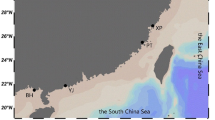Abstract
Chlorostoma rustica is an ecologically and economically important species in China, which plays an important role on the overall function of the coastal systems. Understanding of the genetic structure of C. rustica populations is vital to breeding strategies and conservation programmes. In this study, we isolated and characterized 23 microsatellite loci with high polymorphism using the restriction site-associated DNA sequencing approach. The number of alleles per locus ranged from 6 to 18, and the expected heterozygosities varied from 0. 760 to 0.936. All the polymorphism information content values of the 23 loci were greater than 0.5, indicating that these markers were highly informative and laid the foundation for further genetic analysis.

Similar content being viewed by others
References
Baird N. A., Etter P. D., Atwood T. S., Currey M. C., Shiver A. L., Lewis Z. A. and Johnson E. A. 2008 Rapid SNP discovery and genetic mapping using sequenced RAD markers. PLoS One 3, e3376.
Berman M., Austin C. M. and Miller A. D. 2014 Characterisation of the complete mitochondrial genome and 13 microsatellite loci through next-generation sequencing for the New Caledonian spider-ant Leptomyrmex pallens. Mol. Biol. Rep. 41, 1179–1187.
Dieringer D. and Schlötterer C. 2003 Microsatellite analyser (MSA): a platform independent analysis tool for large microsatellite data sets. Mol. Ecol. Notes 31, 167–169.
Gao X., Zheng X., Bo Q. and Li Q. 2016 Population genetics of the common long-armed octopus Octopus minor (Sasaki, 1920) (Cephalopoda: Octopoda) in Chinese waters based on microsatellite analysis. Biochem. Syst. Ecol. 66, 129–136.
Kalinowski S. T., Taper M. L. and Marshall T. C. 2007 Revising how the computer program CERVUS accommodates genotyping error increases success in paternity assignment. Mol. Ecol. 16, 1099–1106.
Morgante M., Hanafey M. and Powell W. 2002 Microsatellites are preferentially associated with nonrepetitive DNA in plant genomes. Nat. Genet. 30, 194–200.
Ni L., Li Q. and Kong L. 2011 Microsatellites reveal fine-scale genetic structure of the Chinese surf clam. Mactra chinensis (Mollusca, Bivalvia, Mactridae) in Northern China. Mar. Ecol. 32, 488–497.
Reece K. S., Ribeiro W. L., Gaffney P. M., Carnegie R. B. and Allen S. K. Jr. 2004 Microsatellite marker development and analysis in the eastern oyster (Crassostrea virginica): confirmation of null alleles and non-Mendelian segregation ratios. J. Hered. 95, 346–352.
Rousset F. 2008 Genepop’007: a complete re-implementation of the genepop software for Windows and Linux. Mol. Ecol. Res. 8, 103–106.
Thiel T., Michalek W., Varshney R. K. and Graner A. 2003 Exploiting EST databases for the development and characterization of gene-derived SSR-markers in barley (hordeum vulgare L.). Theor. Appl. Genet. 106, 411–422.
Wang Y. and Wei Y. 1994 Ecological investigation of Trochidae (Mollusca) in the intertidal zone of Zhoushan islands, Zhejiang. J. Zhejiang Coll. Fisheries 13, 38–44 (in Chinese).
Yu H. and Li Q. 2008 Exploiting EST databases for the development and characterization of EST-SSRs in the Pacific oyster (Crassostrea gigas). J. Hered. 99, 208–214.
Acknowledgements
This study was supported by the grants from Fundamental Research Funds for the Central Universities (201762014) and Industrial Development Project of Qingdao City (17-3-3-64-nsh).
Author information
Authors and Affiliations
Corresponding author
Additional information
Corresponding editor: Indrajit Nanda
Rights and permissions
About this article
Cite this article
Wang, L., Yu, H. & Li, Q. Identification and characterization of 23 microsatellite loci for Chlorostoma rustica based on RAD-seq. J Genet 97 (Suppl 1), 61–65 (2018). https://doi.org/10.1007/s12041-018-0935-7
Received:
Revised:
Accepted:
Published:
Issue Date:
DOI: https://doi.org/10.1007/s12041-018-0935-7



